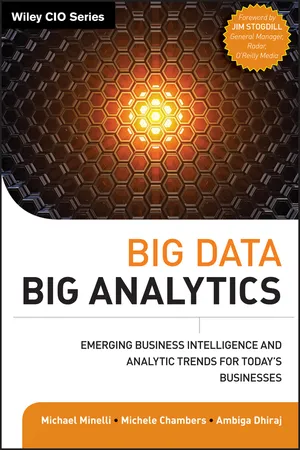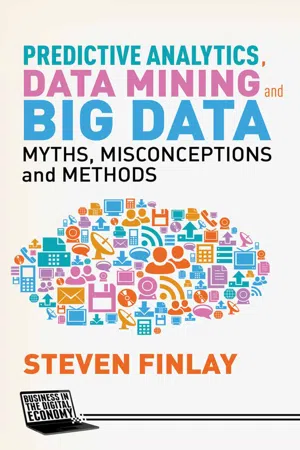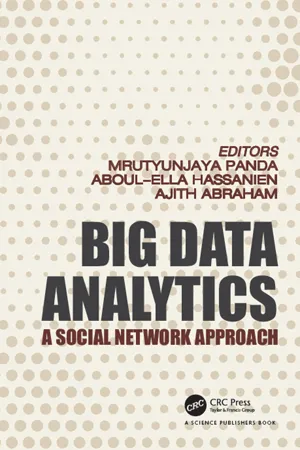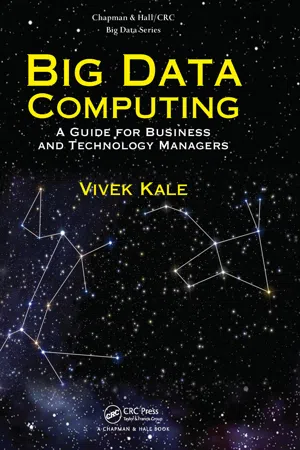Computer Science
Spark Big Data
Spark Big Data refers to the use of Apache Spark, a powerful open-source distributed computing system, for processing and analyzing large-scale datasets. It provides a fast and efficient way to handle big data workloads, offering features such as in-memory processing, fault tolerance, and support for various data sources. Spark Big Data is widely used in data analytics, machine learning, and real-time processing applications.
Written by Perlego with AI-assistance
7 Key excerpts on "Spark Big Data"
Learn about this page
Index pages curate the most relevant extracts from our library of academic textbooks. They’ve been created using an in-house natural language model (NLM), each adding context and meaning to key research topics.
- eBook - ePub
It's All Analytics!
The Foundations of Al, Big Data and Data Science Landscape for Professionals in Healthcare, Business, and Government
- Scott Burk, Gary D. Miner(Authors)
- 2020(Publication Date)
- Productivity Press(Publisher)
www.apache.org ) was incorporated in 1999 as an American nonprofit corporation. Our focus on the foundation in this section has to do with big data systems that support scalable in-database and in-cluster processing of big data – Hadoop and Spark as examples.Hadoop was initially released in 2006 and was widely adopted (with its commercial derivatives) by 2012. According to the Apache Foundation (http://hadoop.apache.org/ ):It offers a software framework for distributed storage (HDFS, Hadoop Distributed File System) and processing of big data using the MapReduce (a parallel, distributed algorithm) programming model.The Apache Hadoop software library is a framework that allows for the distributed processing of large data sets across clusters of computers using simple programming models. It is designed to scale up from single servers to thousands of machines, each offering local computation and storage.Spark was initially released in May of 2014. It was developed by the University of California, Berkeley’s AMPLab and was later donated to the Apache Software Foundation. Spark and its resilient distributed dataset (RDD) were developed in response to limitations in the MapReduce cluster computing paradigm (e.g., Hadoop). Spark’s advantages over Hadoop are speed and performance. The main way it accomplishes this is by using its in-memory data processing. In-memory data processing means slower disk access is eliminated and replaced by random access memory (RAM) or flash memory. This is more expensive, but according to the Apache website, it can run up to 100 times faster (see http://spark.apache.org/ for logistic regression in Spark vs Hadoop).Why the Push to Big Data? Why Is Big Data Technology Attractive?
The technologies of big data came about to support the massive collection and lengthening of processing time when dealing with these huge volumes of data. Users needed to access the data, and analyze and model the data more expediently. From an analytics and data science perspective, there was a major technology and practice shift when adopting Big Data technology. Traditionally, most analysis and machine learning involved moving data from large data repositories (and most of these distributed) into a single “sandbox” for analytics. This involved increasingly more time as the volume of the data increased; it was taking more and more time to move the data across the wire. It also was a security risk since you were moving this data across a network, thus making it easier for someone to tap into sensitive data. - eBook - ePub
Big Data, Big Analytics
Emerging Business Intelligence and Analytic Trends for Today's Businesses
- Michael Minelli, Michele Chambers, Ambiga Dhiraj(Authors)
- 2012(Publication Date)
- Wiley(Publisher)
Apache Avro is a data serialization system that allows for encoding the schema of Hadoop files. It is proficient at parsing data. Part of the Apache Hadoop project. Batch A job or process that runs in the background without human interaction. Big Data The de facto standard definition of big data is data that goes beyond the traditional limits of data along three dimensions: volume, variety, velocity. The combination of these three dimensions makes the data more complex to ingest, process, and visualize. Big Insights IBM’s commercial distribution of Hadoop with enterprise class value added components. Cassandra An open-source columnar database managed by the Apache Software Foundation. Clojure Pronounced “closure.” A dynamic programming language based on LISP (which was the de facto artificial programming language from late 1950s). Typically used for parallel data processing. Cloud General term used to refer to any computing resources—software, hardware or service—that is delivered as a service over a network. Cloudera The first commercial distributor of Hadoop. Cloudera provides enterprise-class value-added components with the Hadoop distribution. Columnar Database The storing and optimizing of data by columns. Particularly useful for some analytics processing that uses data based on a column. - eBook - ePub
Predictive Analytics, Data Mining and Big Data
Myths, Misconceptions and Methods
- S. Finlay(Author)
- 2014(Publication Date)
- Palgrave Macmillan(Publisher)
Suppliers of relational databases are also adapting their offerings to make them better able to deal with large unstructured data sources. Some are approaching this by creating better interfaces with Hadoop, while an alternative approach is to integrate Hadoop like functionality into existing database products and providing enhanced versions of SQL. Consequently, there is increasing overlap between the old and the new when it comes to storing, processing and analyzing data. At some point in the not-too-distant future it may no longer make sense to differentiate between the two. Hadoop is also massively scalable, and you can start small. So if you want to be ready to move into a Big Data world there is no reason why you can’t start running Hadoop on a single server and then scale up as and when you need to.10.5 Software for predictive analytics
There are lots of software packages that can be used to develop predictive models. Some of the most popular packages are SAS, R, IBM SPSS, Stata and RapidMiner. Most of these were originally designed to work on an analytical server or standalone PC/laptop once data had been collated from various sources. However, the vendors of these solutions now provide their software with the functionality to integrate with Big Data solutions such as Hadoop, and/or provide in-database analytical capability. There are also a number of new and emerging tools aimed specifically at Big Data analytics, such as Apache Mahout and Revolution R.Most analytical software can apply a range of analysis and modeling techniques and is generally quite flexible, but each has its own strengths and weaknesses. Consequently, there are a number of factors to consider when deciding what software to use to do predictive analytics: - eBook - ePub
Blockchain
From birth of Internet to future of Blockchain
- Srinivas Mahankali(Author)
- 2019(Publication Date)
- BPB Publications(Publisher)
SQL like data warehouse software used to query data in HDFS TEZ Application Framework built on top of Yarn to process Big data much faster than Map Reduce YARN Resource management and job scheduling technology for Hadoop ecosystem PIG High-level platform for creating programs using Pig Latin Language on HDFS SPARK Unified analytics processing engine with built-in modules for streaming, SQL, machine learning and graph processing. SCALA General-purpose programming language with support for functional programming & a strong static type system. AVRO Row-oriented object container storage format for Hadoop with RPC and data serialization framework CLOUD ERA/ HORTONWORKS Leading IT companies offering Software, support, training and certification for Hadoop co system RDBMS Relational Data Base Management systems NO SQL Not Only SQL IMPALA Open source massively parallel processing SQL query engine for HDFS CASSANDRA Opensource NoSQL database for handling large volumes of data MONGODEB Open-source cross-platform document-oriented NoSQL database program SQOOP Command-line irterface applicatoon to transfer data between RDMS and Hadoop OOZIE Server-based workflow scheduling system to manage Hadoop jobs. ZOOKEEPER Centralized service for maintaining configuration information, naming, providing distributed synchronization, and providing group services in HDFS CLOUD SERVICE PROVIDERS Company offering cloud service as DaaS, SaaS, PaaS, laaS on pay as per use basis DAAS Database as a service SAAS Software as a service PAAS Platform as a service IAAS Infrastructure as a serviceThus the open sourced Apache Hadoop technologies enable organizations to create a large pool of data from various sources, also referred as 'Data Lake' that enables organization to run near real time analytics. Organizations can also create Data Warehouses that have more structured data drawn out of various sources and have schema applied on them for a more structured representation. Organizations like Cloudera, Horton Networks offer various levels of managed services to organizations to set up and run the Big Data operations with varying levels of intervention and corresponding charges. - eBook - ePub
Digital Transformation
Survive and Thrive in an Era of Mass Extinction
- Thomas M. Siebel(Author)
- 2019(Publication Date)
- Rodin Books(Publisher)
In contrast, scale-out architectures use thousands, or tens of thousands, of processors to process data in parallel. To expand capacity, you add more CPUs, memory, and connectivity, thereby ensuring performance does not dip as you scale. The result is a vastly more flexible and less costly approach than scale-up architectures and is ideally suited to handle big data. Software technologies designed to leverage scale-out architectures and process big data emerged and evolved, including MapReduce and Hadoop.Big data as a term first appeared in an October 1997 paper by NASA researchers Michael Cox and David Ellsworth, published in the Proceedings of the IEEE 8 th Conference on Visualization . The authors wrote: “Visualization provides an interesting challenge for computer systems: data sets are generally quite large, taxing the capacities of main memory, local disk, and even remote disk. We call this the problem of big data.”13 By 2013, the term had achieved such widespread circulation that the Oxford English Dictionary confirmed its cultural adoption, including it in that year’s edition of the OED .In 2001, Doug Laney—then an analyst at META Group—described three main traits that characterize big data: volume (the size of the data set, as measured in bytes, gigabytes, exabytes, or more); velocity (the speed of data arrival or change, as measured in bytes per second or messages per second or new data fields created per day); and variety (including its shape , form, storage means, and interpretation mechanisms).14Size, Speed, and ShapeBig data continues to evolve and grow along all three of these dimensions—size, speed, and shape. It’s important for senior executives—not just the technologists and data scientists in the organization—to understand how each of these dimensions adds value as a business asset.Size . The amount of data generated worldwide has increased exponentially over the last 25 years, from about 2.5 terabytes (2.5 × 101 2 bytes) a day in 1997 to 2.5 exabytes (2.5 × 101 8 - eBook - ePub
Big Data Analytics
A Social Network Approach
- Mrutyunjaya Panda, Ajith Abraham, Aboul Ella Hassanien, Mrutyunjaya Panda, Ajith Abraham, Aboul Ella Hassanien(Authors)
- 2018(Publication Date)
- CRC Press(Publisher)
12 Big Data Analysis Technology and ApplicationsSuprem AbhijitSchool of Computer Science, Georgia Institute of Technology, USA; [email protected]IntroductionBig data is a nebulous term that incorporates a variety of areas—from large-scale data collection, to storage methodologies, to analytics, to visualization. In each of these cases, the challenge is on efficient data operation on huge amounts of data. As computing power, hardware and storage continues to increase, there is no clear indication on what exactly the ‘big’ in big data means. Commonly, however, big data refers to giga-, tera-, or peta-scale data, such as text corpora from millions of books, the billions of images in Facebook’s database, or the trillions of file signatures in security companies’ malware identification databases.Large-scale data collection is common in both industry and the public sector, and the presence of various collection agencies as financial entities, social media corporations, and public- and industry-sector monitoring organizations has significantly increased the volume of data collected and made publicly available. Modern research and development in big data goes beyond the collection and management paradigm and enters the domain of visual and data analytics. The former is concerned with effective interaction and visualization tools for developers and end-users to better analyze and tune tools, respectively. The latter deals with myriad domain-specific frameworks, platforms and algorithms for a variety of analytics applications including data mining, prediction, ranking, language processing, financial modeling, human-computer interaction, and automated summarization. This survey covers the two broad research areas—visual analytics and data analytics, and details current trends and research in information visualization and large-scale analytics.This paper provides a survey of big data tools and systems. We cover the data analytics pipeline, from data collection through crowdsourcing to data exploration and visualization. We then describe the two major parallelized data analytics models: MapReduce and Spark. The rest of the paper discusses various analytics applications for big data, such as recommender systems, graph analytics tools, cyber security, and social networks. - eBook - ePub
Big Data Computing
A Guide for Business and Technology Managers
- Vivek Kale(Author)
- 2016(Publication Date)
- Chapman and Hall/CRC(Publisher)
Big data is the commercial equivalent of HPC, which could also be called high-performance commercial computing or commercial supercomputing. Big data can also solve large computing problems, but it is less about equations and more about discovering patterns. Today companies such as Amazon, eBay, and Facebook use commercial supercomputing to solve their Internet-scale business problems. Big data is a type of supercomputing for commercial enterprises and governments that will make it possible to monitor a pandemic as it happens, anticipate where the next bank robbery will occur, optimize fast-food supply chains, predict voter behavior on election day, and forecast the volatility of political uprisings while they are happening.Big data can be defined as data sets whose size is beyond the ability of typical database software tools to capture, store, manage, and analyze. Big data is different from the traditional concept of data in terms of the following:• Bigger volume: There is more than a half-a-trillion pieces of content (photos, notes, blogs, web links, and news stories) shared on Facebook every month and 4 billion hours of video are watched at YouTube every month. It is believed that there will be more than 50 billion connected devices in the world by 2020.• Higher velocity: At 140 characters per tweet, Twitter-generated data volume is larger than 10 terabytes per day. It is believed that more data were created between 2008 and 2011 than in all history before 2008.•






